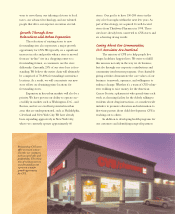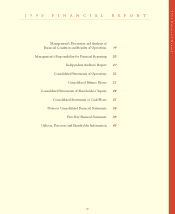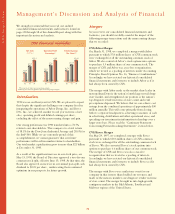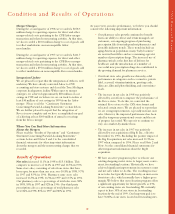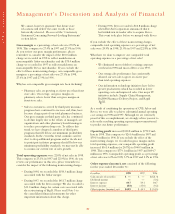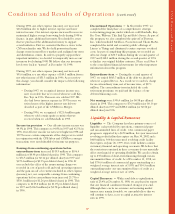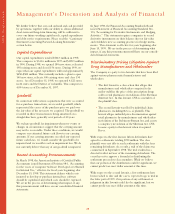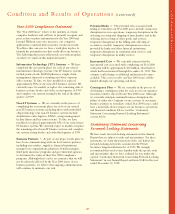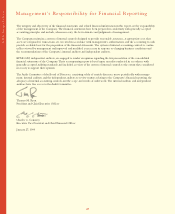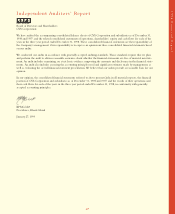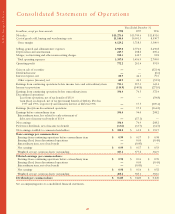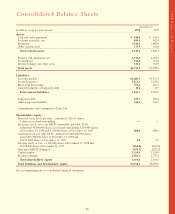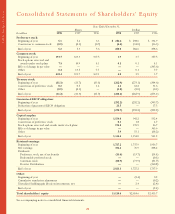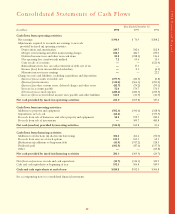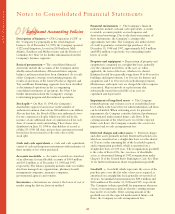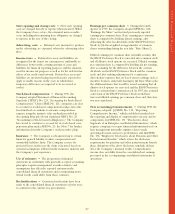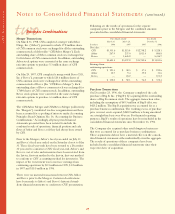CVS 1998 Annual Report Download - page 20
Download and view the complete annual report
Please find page 20 of the 1998 CVS annual report below. You can navigate through the pages in the report by either clicking on the pages listed below, or by using the keyword search tool below to find specific information within the annual report.
18
CVS Corporation
In June 1998, the Financial Accounting Standards Board
issued Statement of Financial Accounting Standards No.
133, “Accounting for Derivative Instruments and Hedging
Activities.” This statement requires companies to record
derivative instruments on their balance sheet at fair value
and establishes new accounting practices for hedge instru-
ments. This statement is effective for years beginning after
June 15, 1999. We are in the process of determining what
impact, if any, this pronouncement will have on our consoli-
dated financial statements.
Discriminatory Pricing Litigation Against
Drug Manufacturers and Wholesalers
The Company is a party to two lawsuits that have been filed
against various pharmaceutical manufacturers and
wholesalers:
•The first lawsuit is a class action that alleges that
manufacturers and wholesalers conspired to fix
and/or stabilize the price of the prescription drugs
sold to retail pharmacies in violation of the Sherman
Antitrust Act. In this lawsuit, CVS is a member of
the plaintiff class.
•The second lawsuit was filed by individual chain
pharmacies, including Revco, as plantiffs. This
lawsuit alleges unlawful price discrimination against
retail pharmacies by manufacturers and wholesalers
in violation of the Robinson-Patman Act, and asserts
a conspiracy in violation of the Sherman Act. CVS
became a party to this lawsuit when it acquired
Revco.
With respect to the first lawsuit, fifteen defendants have
agreed to settlements totaling $720 million. The class
plaintiffs were not able to reach settlements with the four
remaining defendants. As a result, a trial of the claims was
commenced in September 1998. The trial resulted in a
directed verdict in favor of the remaining defendents. The
court has yet to approve a formula for distributing the
settlement proceeds to class members. While we believe
that our portion of the distribution could be significant, we
cannot predict an exact dollar amount at this time.
With respect to the second lawsuit, a few settlements have
been reached to date and the case is expected to go to trial in
the latter part of 1999. Our portion of any settlement or
judgment in this lawsuit could also be significant, but we
cannot predict an exact dollar amount at this time.
We further believe that our cash on hand and cash provided
by operations, together with our ability to obtain additional
short-term and long-term financing, will be sufficient to
cover our future working capital needs, capital expenditures
and debt service requirements. Please read the “Cautionary
Statement Concerning Forward-Looking Statements”
section below.
Capital Expenditures
Our capital expenditures totaled $502.3 million in 1998.
This compares to $341.6 million in 1997 and $328.9 million
in 1996. During 1998, we opened 184 new stores, relocated
198 existing stores and closed 156 stores. During 1999, we
expect that our capital expenditures will total approximately
$450-$500 million. This currently includes a plan to open
140 new stores, relocate 300 existing stores and close 130
stores. As of December 31, 1998, we operated 4,122 stores
in 24 states and the District of Columbia. This compares to
4,094 stores as of December 31, 1997.
Goodwill
In connection with various acquisitions that were accounted
for as purchase transactions, we recorded goodwill, which
represented the excess of the purchase price we paid over
the fair value of the net assets we acquired. The goodwill we
recorded in these transactions is being amortized on a
straight-line basis, generally over periods of 40 years.
We evaluate goodwill for impairment whenever events or
changes in circumstances suggest that the carrying amount
may not be recoverable. Under these conditions, we would
compare our estimated future cash flows to our carrying
amounts. If our carrying amounts exceeded our expected
future cash flows, we would consider the goodwill to be
impaired and we would record an impairment loss. We do
not currently believe that any of our goodwill is impaired.
Recent Accounting Pronouncements
In March 1998, the American Institute of Certified Public
Accountants issued Statement of Position 98-1, “Accounting
for the Costs of Computer Software Developed or Obtained
for Internal Use,” effective for fiscal years beginning after
December 15, 1998. This statement defines which costs
incurred to develop or purchase internal-use software
should be capitalized and which costs should be expensed.
We are in the process of determining what impact, if any,
this pronouncement will have on our consolidated financial
statements.
Management’s Discussion and Analysis of Financial





